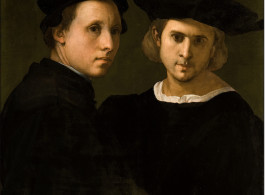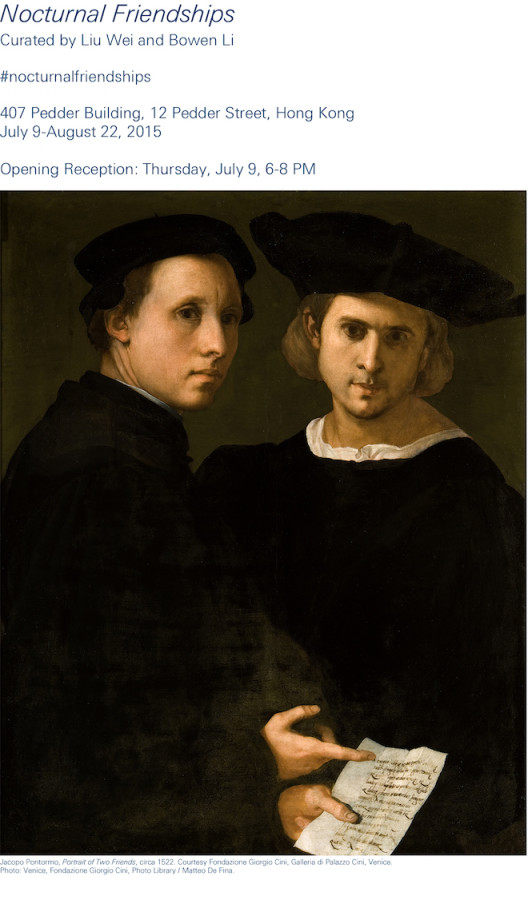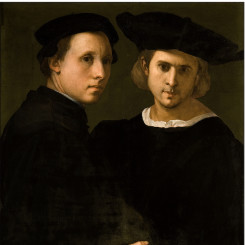Hong Kong, June 26, 2015—Lehmann Maupin Hong Kong is pleased to present Nocturnal Friendships, an exhibition that examines various forms of friendship and considers the idea of friendship in relation to desire, the erotic, and death. Curated by acclaimed artist Liu Wei and Bowen Li, the exhibition features the work of Chinese artists Hu Xiangqian, Peng Jian, Tang Yongxiang, Tant Zhong, Yu Ji, Zhang Ruyi, and Zhu Tian.
The exhibition theme, and the use of Pontormo’s Portrait of Two Friends to illustrate the concept of the exhibition, stem from Treatise on Friendship, the Roman philosopher Cicero’s Latin text from 44 BCE. Depicted in Pontormo’s painting, Treatise on Friendship explores Cicero’s personal experiences with friendship, outlining what makes a good friend and conversely a bad one, the importance of virtue in friendship, and how one is affected by the death of a friend. Indeterminate areas of friendship are suggested by use of the word “nocturnal” in the exhibition title, which is taken from German philosopher Friedrich Nietzsche. Nietzsche proposed that by wishing you the “best” in life, a true friend actually wishes you the “worst”—including strife, struggle, and obstacles. By comparison, “nocturnal friendships” manifest themselves as insignificant relationships, or those without substance or foundation. Together the artworks in the exhibition articulate the concept of “nocturnal friendship”. While all demonstrate their own unique language, they are in dialogue with each other through various commonalities, such as ideas of absurdity, the interaction of the natural with the man-made, and how humanity operates within a larger mechanical society.
In curating this exhibition, Liu Wei and Bowen Li have selected the work of seven young artists, all born in Mainland China, whose practices range from performance to abstract sculpture. They include:
Hu Xiangqian is inspired by current events and his own surroundings, and documents his performances in video or photography. The artist’s works often convey some sort of journey or transformation, usually pointing out an absurdity or conflict within society. In one of his best-known works, Hu Xiangqian documents his attempt to run for mayor of his hometown. In the video Two Men (2008), the artist dances joyfully with another man, examining the impact of friendship and brotherly love.
Peng Jian deliberately merges Western and Chinese painting traditions, approaching the Song Dynasty ruled-line architectural painting style with a contemporary aesthetic. Applied here to books rather than buildings, his still life Mountain within Mountains (2014) depicts Chinese texts, Rubik’s Cubes, and various other signifiers of the relationship between the East and West, giving them an abstract and weightless quality.
Tang Yongxiang’s meticulously layered paintings address the idea of concealment. This appears through the combination of visually covering parts of images and revealing others, reorganizing and liberating certain fragments; these depictions parallel the idea of obscuring judgment and ideology that underlies his works. In A Lot of Dark Blue Legs and Patches of Color (2015), multiple pairs of women’s legs span the canvas, yet the concealment of the rest of their bodies removes any erotic context or individuality.
While not willing to classify her work in a particular genre, Tant Zhong pays homage to conceptual art, vividly questioning what it means to produce an artwork. Using her photographs as a way to express a moment of her experience in the world, she gives attention to the rarely addressed or neglected elements of society. In the series Double Click (2014), pairs of photographs show the same image, yet each from a slightly different perspective, testifying to their respective individuality and relationship to one another.
Yu Ji considers the installation of her minimal and abstract sculptures a performance that the viewer will later encounter. Created from cement and iron, Petal (2014) and Flesh in Stone #4 (2014) have anthropomorphic qualities; the industrial materials contrast the sculptures’ organic forms, existing in a transient state between natural and man-made.
Zhang Ruyi’s mixed media works on paper are extensions of her site-specific sculptures, for which she is best known. Though highly structured, using grids and matrixes, Zhang Ruyi’s work incorporates abstract organic forms, bringing an element of humanity into the composition. Her concrete sculptures, often blocking doors or windows, alter the architectural space in which they are placed. By cutting off or redirecting the paths that humans rely on to connect with the outside world, she questions the necessity of social interaction.
Often bordering the absurd, Zhu Tian’s sculptures and performances convey a mixture of humor and provocativeness. Even the materials she uses waiver between seductive and off-putting. Concerned with the division of power in a relationship, she also addresses the idea and reality of freedom and individualism. The series Scan (2014) features the artist half nude, contorted into various poses over a scanner on a wooden floor. However, her actions don’t appear to be purpose driven or make sense; it is the artist’s intention for her work to be an interruption or disruption in the viewer’s everyday thought process.
About Liu Wei
Liu Wei (b. 1972, Beijing, China) explores 21st-century socio-political concepts, such as the contradictions of contemporary society and the transformation of developing cities and the urban landscape. In many of his sculptural and installation works he re-contextualizes found materials to draw new meanings out of the materials from which they are made. He frequently uses geometric and architectural forms in his work as a reference to his urban surroundings. Liu Wei’s work has been featured in exhibitions around the world, most recently at the Ullens Center for Contemporary Art, Beijing (2015 and 2010); the Rubell Collection, Miami (2014); Long Museum, Shanghai (2014); Minsheng Art Museum, Shanghai (2011); Centre Georges Pompidou, Paris (2010); National Art Museum of China, Beijing (2010); Long March Space, Beijing (2010); Saatchi Gallery, London (2008); Bonniers Konsthall, Stockholm (2008); and Mudam Luxembourg, France (2008), among other venues. He has participated in numerous international biennials, including the 11th Sharjah Biennial (2013); Shanghai Biennial (2010); Busan Biennial (2008); Guangzhou Triennial, (2008); and 51st Venice Biennale (2005). The artist lives and works in Beijing, China.
About Lehmann Maupin
Founded in 1996 by partners Rachel Lehmann and David Maupin, Lehmann Maupin has fostered the careers of a diverse group of internationally renowned artists, both emerging and established, working in multiple disciplines and across varied media. With three locations—two in New York and one in Hong Kong—the gallery represents artists from the United States, Europe, Asia, South America, Africa, and the Middle East. Known for championing artists who create groundbreaking and challenging forms of visual expression, Lehmann Maupin presents work highlighting personal investigations and individual narratives through conceptual approaches that often address such issues as gender, class, religion, history, politics, and globalism.
Current & Upcoming Exhibitions
Patrick Van Caeckenbergh, through August 21, 2015, New York, Chrystie Street
Robin Rhode, Borne Frieze, through August 21, 2015, New York, West 22nd Street
Matthias Weischer, September 3-October 3, 2015, Hong Kong, Pedder Building
Nari Ward, September 9-November 1, 2015, New York, Chrystie Street
Billy Childish, September 10-October 31, 2015, New York, West 22nd Street
Adriana Varejão, October 8-November 14, 2015, Hong Kong, Pedder Building
Teresita Fernández, November 5-December 12, 2015, New York, West 22nd Street
Roberto Cuoghi, November 8-December 13, 2015, New York, Chrystie Street
Shirazeh Houshiary, November 19, 2015-January 9, 2016, Hong Kong, Pedder Building



